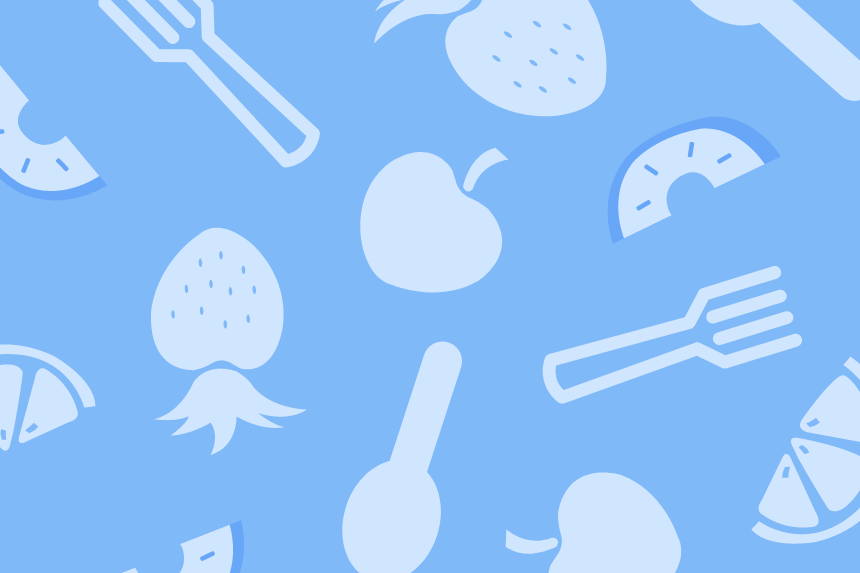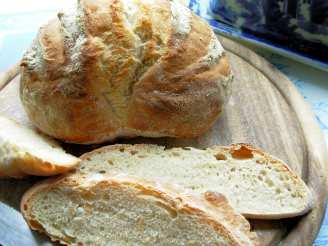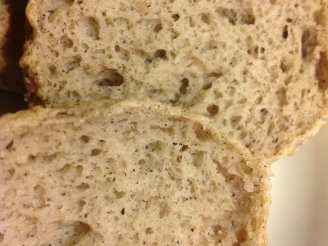DAILY BREAD

- Ready In:
- 10hrs 20mins
- Ingredients:
- 5
- Yields:
-
1 Loaf
ingredients
- 1 teaspoon active dry yeast
- 1 teaspoon granulated sugar
- 1 cup warm water
- 2 1⁄4 - 2 3⁄4 cups unbleached all-purpose flour
- 3⁄4 - 1 teaspoon salt
directions
- Food Processor Method: You can make this bread dough in a number of different ways. The simplest, by far, is in a food processor using the plastic dough blade. Pour the warm water into the processor and sprinkle the yeast and sugar on top. Put the lid on the processor and pulse for a split second, just to wet the yeast. Add 1 cup of the flour, process for 10 seconds, and let rest for 10 minutes. This gets the yeast going, lets the flour start to absorb the liquid, and is a good time to do the breakfast dishes.
- Add the salt and the remaining flour, between 1 1/4 and 1 3/4 cups, and process for 1 minute. You'll need about 1 1/4 cups in the winter, 1 1/3 cups in the summer, and 1 1/2 cups in the spring or fall. Because flour absorbs moisture from the air, and the air is moister in summer than winter, the amount of flour you'll need in your bread recipes will be less in winter, more in summer. You're trying to attain a very slack dough, one which will barely form a rough ball in the food processor.
- Remove the dough from the food processor bowl, place it in a large, lightly greased bowl, and cover with lightly greased plastic wrap. Set aside and go on about your work.
- Mixer Method: You can also make this dough in a stand mixer using either a dough hook or paddle. Follow the same procedure outlined above.
- Bread Machine Method: You can even do this in your bread machine. Simply put all the ingredients in at once, let the machine go through its first knead (25 minutes or so), then turn off the machine, take the dough out, and put it into a lightly greased bowl, covered with lightly greased plastic wrap.
- Hand Method: Finally, you can do this with -- gulp! -- your hands. Stir the ingredients together well with a spoon, then knead it with your hands in the bowl for 8 to 10 minutes, until you've made a very slack dough. Place the dough in a large, lightly greased bowl, and cover it with lightly greased plastic wrap.
- Shaping: Between 8 and 10 hours later, take the dough out of the bowl and make it into whatever you want. You'll have enough dough to make eight rolls, eight chewy, substantial breadsticks, one Italian-style loaf or baguette, one round loaf, or a 12-inch focaccia. I usually opt for the focaccia, drizzling it with olive oil, then sprinkling it with a healthy amount of black pepper, a bit of salt, and some rosemary.
- Let the dough rise again, for an hour or so, until whatever you've shaped is good and puffy. Preheat the oven to 450°F about half an hour before you want to bake the bread.
- Baking: Bake the bread for 15 to 20 minutes, misting the inside of the oven with cold water from a clean plant mister three or four times during the first 5 to 8 minutes of baking, if you're after a very crisp crust. Remove the bread from the oven when it's golden brown, and cool it on a wire rack or bring it to the table and eat it immediately.
- As you can see, this bread is basically non-fat, and very low-calorie if you don't gild it with butter, garlic oil, etc. However, this bread cries to be dunked in a seasoned olive oil. Think of it this way: it's perfectly healthful and nutritious to begin with, and you do need a bit of fat in your diet, and olive oil, being preponderantly monounsaturated, is arguably the best kind of fat you can eat. Go for it!
Questions & Replies
Got a question?
Share it with the community!
Reviews
Have any thoughts about this recipe?
Share it with the community!
RECIPE SUBMITTED BY
VelcrowMistress
Riverside, California


